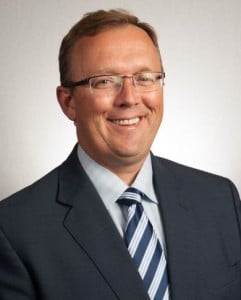by Brian Taylor
“Signal & Noise” is a bimonthly column by Brian Taylor, AuD.

Brian Taylor, AuD
About a year ago, I had the privilege of co-authoring a book with Vinaya Manchaiah of Lamar University. We never expected the book, titled The Role of Communication Partners in the Audiological Rehabilitation, to be a big seller (I can assure you, it is not), but we hoped it would garner some interest from some forward-thinking clinicians, academics and other thought leaders within the profession. The topic of family-centered or patient-centric communication is gaining relevance in Audiology, and our book, which takes a deep dive into the active involvement of spouses and significant others in the treatment process, fits squarely into that movement.
Shortly after publication, we discovered someone was writing a review of our book for the International Journal of Audiology (IJA). That review, written by Berth Danermark, recently appeared in IJA. Before I read the review, I was curious, who is Berth Danermark? Well, it turns out he’s a prominent Swedish sociologist, renowned enough to have his own Wikipedia page. Danermark’s review of our book was generally very positive; however, he had one rather scathing critique of our work that caught my attention. He wrote that he found our embrace of the traditional communication model — the sender-receiver-medium approach, similar to how a person might listen to a podcast or TV show, to be outmoded and disturbing. Wow, disturbing. A strong word to describe something I took for granted – isn’t the sender-receiver-medium approach (and the disorders and conditions associated with the receiver) how all communication is conducted?
Communication Models and “New” Theories
After getting over the initial sting of his criticism, his comments that communication is a joint activity and the raison d’etre for involving a communication partner genuinely sparked my curiosity. I had never heard communication and hearing loss couched in such existential terms. Since he listed a few sources of “state of the art communication theories and research” at the end of his review, I used it as an opportunity to learn about these “new” theories.
Thanks to the long tail of Amazon, I was able to obtain the references he cited. First, I learned the theories he referred to in his review are not new. They have been around for more than 20 years. IF that’s the case, it’s a fair question to ask why these theories about communication are not more popular among audiologists? Second, I found Danermark’s book, (Re)capturing the Conversation: A Book About Hearing Loss and Communication to be very illuminating. It’s a short read, you can get through the entire book in an hour, and if you’re a professional who works with hearing impaired adults, it’s a handy little book filled with practical insights on the plight of adults with hearing loss.
Danermark breaks the book into two parts. In part one he deftly addresses the complex social actions of conversations. He emphasizes that although conversation looks haphazard and spontaneous, it is a demanding form of cooperation between people who must abide some basic improvisational rules. He highlights some of the accepted rules of conversation that everyone innately follows: sequencing, identifying the context, joint meaning making and the division of labor within a conversation. As you might expect, people with hearing difficulties, and those conversing with them, must cope with the emotional and social consequences of no longer being able to unconsciously follow these rules.
In part two, as the title of his book implies Danermark lays the groundwork for how audiologists can help both the person with hearing loss and their communication partners overcome the effects of these weakened or missing improvisational conversation skills. In the Danermark model, the role of the audiologist is provide insight and training to both the person with hearing loss and their key communication partners so that they can re-learn together how to jointly distribute the work of an free-flowing conversation. The professional’s role in the “re-capturing” process is manifold and includes:
- Raising awareness of lost conversation skills and providing repair strategies so that both parties know the difference between a spontaneous and orderly conversation,
- Demonstrating how to ask and answer when someone has not fully understand or heard something, and
- Helping both parties recognize and manage feelings or perceptions such as disinterest, rudeness or alienation associated with an inability to hear during a freely flowing conversation.
I cannot recommend Danermark’s book enough. It took me beyond my own device-centric thinking and placed it squarely on trying to understand and facilitate the re-use of conversational skills in people with hearing loss. No matter what hearing aid or amplification device a patient chooses to use, the ability to share in the solidarity of improving communication ability across all situations, transcends the specific hearing devices they might be wearing. Danermark’s book reminds us the role of a good counselor is engaging in the tough (yet rewarding) work of helping both the patient and their key communication partners re-learn a deeply human skill – a spontaneous conversation.
My guess is many audiologists feel caught in this mindset: We target a set of treatment goals based on where a patient wants to hear better, and then we focus on the treatment plan (usually hearing aids) that will perform the best in those situations. After all, isn’t that what a commonly used clinical tool, the COSI, is intended to do?
Obviously, targeting treatment goals around place remains a worthy aim (who doesn’t want to enjoy watching TV or listening to music), but with every patient and communication partner in need of our help, there is an opportunity to take a deeper dive into their thoughts and feelings about day-to-day conversations with others.
The twist Danermark’s work brings to the table is twofold: One, during the treatment planning and goal setting process, talk about the emotions associated with hearing loss and look to pair those emotions with the places patients and their communication partners want to converse. Another commonly used clinical tool, the abbreviated version of the Hearing Handicap Inventory for Adults with its social and emotional subscales is a vehicle for talking about the real impact hearing loss has on conversations. For example, the subscale questions on the HHI-A that ask about embarrassment and frustration, are perfect opportunities to ask pointed follow-up questions about those emotions to both parties. “You marked a ‘yes’ on this question about frustration, let’s talk about how frustrated you feel and where you feel that way.”
Two, during the rehab process, work in unity with both parties to ensure they are jointly distributing the work associated with a free-flowing conversation. In other words, rather than simply focusing on where patients and communication partners desire improved communication provide them with tools and insights that allow both parties to recapture the conversation no matter the situation.
In the emerging era of self-directed care and OTC hearing aids, providing systematic guidance, insight and practical knowledge to patients that enables them to re-connect with others through conversation is a very human skill. One that cannot be duplicated by computer algorithms or artificial intelligence and must be provided face-to-face by an audiologist.
Brian Taylor, AuD, is the director of clinical audiology for the Fuel Medical Group. He also serves as the editor of Audiology Practices, the quarterly journal of the Academy of Doctors of Audiology, and editor-in-chief of Hearing News Watch for HHTM. Brian has held a variety of positions within the industry, including stints with Amplifon (1999-2008) and Unitron (2008-2015). Dr. Taylor has more than 25 years of clinical, teaching and practice management experience. He has written and edited six textbooks, including the third edition of Audiology Practice Management, recently published by Thieme Press. He lives in Minneapolis, MN and can be reached at [email protected]
*feature image courtesy of Cambridge in Color







